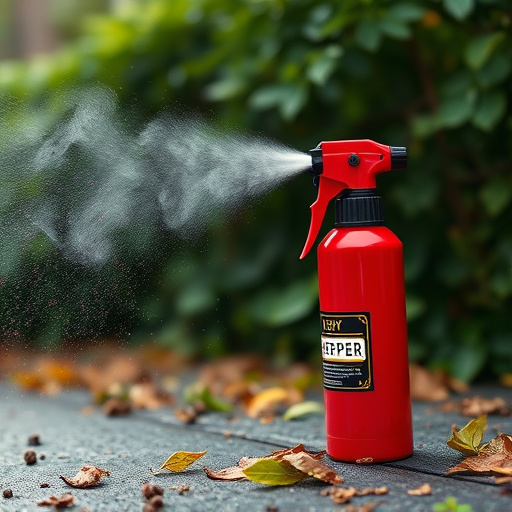OC spray (pepper spray) is a popular civilian self-defense tool containing capsaicin, an ingredient from chili peppers, in concentrations of 1% – 20%. Effective deterrents with mid-range levels (5%-10%) are recommended for civilians, balancing protection and safety. Its use is regulated, requiring permits or registration in many areas to ensure responsible handling. Training is essential for understanding capsaicin concentration levels, application techniques, and legal considerations to use OC spray safely as a last resort.
“The quest for personal protection has led many civilians to explore non-lethal self-defense options. One such tool gaining traction is inflammatory spray, specifically those containing capsaicin. This article delves into the world of OC (Oleoresin Capsaicin) spray, exploring its effectiveness tied to capsaicin concentration levels, legal considerations for civilian use, and crucial safety guidelines. Understanding these aspects empowers individuals to make informed decisions about leveraging OC spray as a responsible self-defense mechanism.”
- Understanding OC Spray: A Non-Lethal Self-Defense Option for Civilians
- Capsaicin Concentration: The Key to Effective Inflammatory Sprays
- Legal Considerations and Civilian Use of OC Spray
- Safety, Training, and Responsible Use of Inflammatory Sprays for Personal Protection
Understanding OC Spray: A Non-Lethal Self-Defense Option for Civilians
OC spray, also known as pepper spray, is a non-lethal self-defense option that has gained popularity among civilians seeking to protect themselves in various situations. This type of spray contains capsaicin, the active ingredient derived from chili peppers, which irritates the eyes and respiratory system when inhaled. The capsaicin concentration levels in OC spray vary, with common concentrations ranging from 1% to 2%.
When used properly, OC spray can provide a crucial window of opportunity for civilians to escape or de-escalate a potentially dangerous situation. The spray creates a temporary yet intense irritation, disorienting the aggressor and allowing the user to retreat to safety. Understanding OC spray’s mechanics, including its capsaicin concentration levels, is essential for anyone considering it as a personal defense tool.
Capsaicin Concentration: The Key to Effective Inflammatory Sprays
The effectiveness of an inflammatory spray, often referred to as OC (Oleoresin Capsaicin) spray, is directly tied to its capsaicin concentration levels. Capsaicin, the active ingredient derived from chili peppers, creates a burning sensation when it comes into contact with the skin or mucous membranes. The potency of this irritant determines the spray’s ability to incapacitate an assailant temporarily and enable the user to escape or seek help.
OC sprays typically contain capsaicin in concentrations ranging from 1% to 20%. Lower concentrations may provide a mild stinging sensation, while higher concentrations can cause intense pain and respiratory distress, making it difficult for an attacker to continue fighting. For civilian protection purposes, mid-range concentrations around 5% to 10% are commonly recommended, as they offer sufficient deterrence without causing long-term harm or leaving users unable to function.
Legal Considerations and Civilian Use of OC Spray
The civilian use of OC spray, also known as pepper spray, is a topic that comes with intricate legal considerations. While law enforcement agencies have long relied on OC spray for crowd control and self-defense, its accessibility to civilians has sparked debates worldwide. The primary concern revolves around the potential misuse and the capsaicin concentration levels in these sprays.
OC spray contains capsaicin, a chemical derived from chili peppers, which irritates the eyes, skin, and respiratory system. Different countries and regions have implemented strict regulations regarding the sale and possession of OC spray by civilians, often requiring permits or registration. These rules are designed to ensure responsible use and prevent its misuse as a weapon. The legal framework also dictates the maximum capsaicin concentration levels permitted for civilian-grade sprays, balancing the need for effectiveness with public safety.
Safety, Training, and Responsible Use of Inflammatory Sprays for Personal Protection
The safety and responsible use of inflammatory sprays, commonly known as OC spray or pepper spray, are paramount when considering them for personal protection. These powerful tools should only be employed as a last resort when facing an imminent threat. Users must undergo adequate training to understand the spray’s effects, proper application techniques, and de-escalation strategies. Familiarity with local laws and regulations regarding civilian possession and use is essential to avoid legal repercussions.
Training programs typically cover OC spray capsaicin concentration levels, which can range from 1% to 20%. Participants learn how to accurately assess a situation, determine the appropriate distance for deployment, and target specific areas to maximize effectiveness while minimizing collateral damage. Responsible use involves understanding the limitations of the spray, including its short-lived effects and potential for temporary blindness or respiratory distress in some individuals. Regular refreshers are recommended to ensure users remain proficient and responsible in their handling of such a powerful tool.
OC Spray, with its active ingredient capsaicin, offers civilians a powerful yet non-lethal self-defense option. Understanding the capsaicin concentration levels is crucial for effective protection, as higher concentrations provide longer-lasting effects. However, legal considerations and responsible use are paramount to ensure safety and avoid misuse. Proper training in handling and deployment, along with adherence to guidelines, enables individuals to leverage OC Spray effectively while mitigating potential risks, making it a valuable tool for personal protection in appropriate circumstances.
